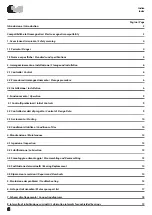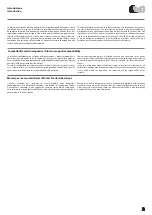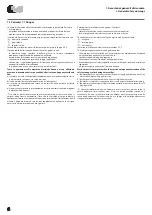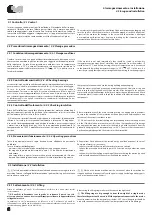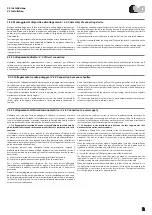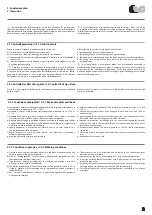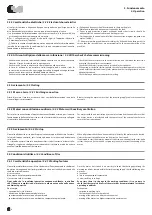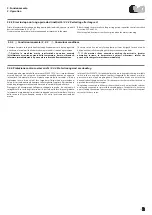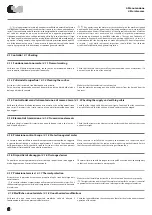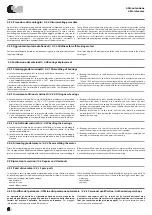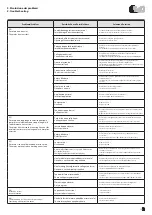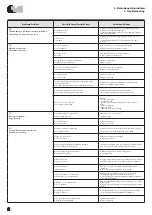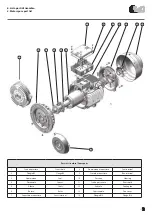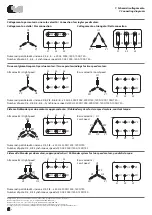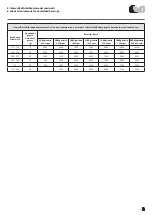
9
Brain Power
3. Funzionamento
3. Operation
3.1 Controlli preliminari
/
3.1 Initial Controls
3.2 Controllo dei dati di progetto
/
3.2 Control of Design Data
3.2.1 Condizioni ambientali
/
3.2.1 Environmental conditions
3.2.2 Condizioni operative
/
3.2.2 Working conditions
La determinazione dell’idoneità di un motore all’interno di un impianto
specifico, previa analisi delle caratteristiche di pericolo dell’area di installazione
relativamente alle disposizioni a norma di legge in vigore e a quelle emanate ai
fini di sicurezza, sono di responsabilità dell’installatore.
Prima di avviare il motore, è fondamentale verificare che:
a) l’installazione sia stata effettuata correttamente
b) i cuscinetti non siano stati danneggiati durante l’installazione
c) il basamento del motore sia sufficientemente robusto e le viti di fondazione
siano serrate
d) i dati del progetto corrispondano a quelli riportati sulla targhetta e nella
documentazione tecnica
Il motore elettrico è un componente progettato per essere collegato
meccanicamente a un’altra macchina (singola o parte di un impianto). Pertanto,
è compito della persona responsabile dell’installazione assicurare un livello
adeguato di protezione di cose e persone da danni derivanti da contatti
accidentali con le parti in movimento durante il funzionamento.
Assicurarsi che il motore sia adatto alle condizioni di lavoro previste e verificare
quanto segue:
a) temperatura ambiente: il motore standard chiuso è in grado di funzionare a
temperature comprese tra -15°C e +40°C
b) altitudine: i motori ordinari sono stati progettati per operare tra 0 e 1000 m
s.l.m.
c) protezione contro la presenza di agenti pericolosi, quali: sabbia, sostanze
corrosive, polvere e/o fibre, acqua, stress meccanico e vibrazioni
d) protezione meccanica: installazione interna o esterna in funzione degli effetti
negativi delle condizioni atmosferiche, dell’effetto combinato di temperatura
e umidità e della formazione di condensa
e) spazio adeguato in prossimità del motore, specie sul lato ventola, che
consenta una ventilazione idonea
f) motori montati in senso verticale, albero con copertura di protezione
all’ingresso del ventilatore
g) eventuali pericoli di esplosione o incendio.
a) Il motore deve essere assemblato e messo in funzione esclusivamente nella
forma indicata sull’apposita targhetta.
b) Tipo di funzionamento: i motori sono generalmente progettati per un
funzionamento continuo intensivo S1.
c) Tipo di carico: valutare attentamente le macchine con momenti di inerzia
elevati e i relativi tempi di avviamento.
d) Per motori progettati per il funzionamento in aree pericolose (Ex d o Ex e),
il tipo di motore e la classificazione della temperatura devono rispettare il
rating dell’area.
e) Per i motori autofrenanti, vedere le specifiche applicazioni proposte
nell’apposito catalogo.
It is the responsibility of the installer to establish the motor’s fitness to be used
in a certain plant, after analysing the characteristics of danger existing in the
installation area with respect to current provisions of the law and to those issued for
safety purposes.
Before starting the motor it is important to check that:
a) installation has been carried out properly
b) the bearings have not been damaged during installation
c) the motor base is sturdy enough and the foundation bolts have been tightened
d) the design data corresponds to those given on the plate and in the technical
documentation
The electric motor is a component made to be mechanically connected to
another machine(single or part of a plant). Consequently, it is the task of the person
responsible for the installation to guarantee that during operation there is an
adequate degree of protection for people or things against the danger of accidental
contact with moving parts.
Make sure that the motor is suited for use in the working conditions foreseen and
check the following:
a) ambient temperature: standard closed motors can operate between -15°C and
+40 °C.
b) altitude: normal motors have been designed to work between 0 and 1.000 m
above sea level
c) protection against the presence of harmful agents like: sand, corrosive substances,
dust and/or fibre, water, mechanical stress and vibrations
d) mechanical protection: installation inside or outside considering the harmful
effects of the weather, the combined effect of temperature and humidity and the
formation of condensation
e) adequate space around the motor especially on the fan side to allow proper
ventilation
f) motors mounted in the vertical,shaft down require a protective cowl over the fan
inlet
g) any danger of explosion or fire.
a) The motor must only be assembled and operated in the construction form
indicated on the motor plate.
b) Operation type: the motors are normally for S1 duty continuous operation.
c) Load type: carefully evaluate machines with high moments of inertia and the
relative starting times.
d) For motors intended for operation in hazardous areas (Ex d or Ex e) the motor type
and temperature classification must comply with the area rating.
e) For self-braking motors see the special applications envisaged in the relative
catalogue.


